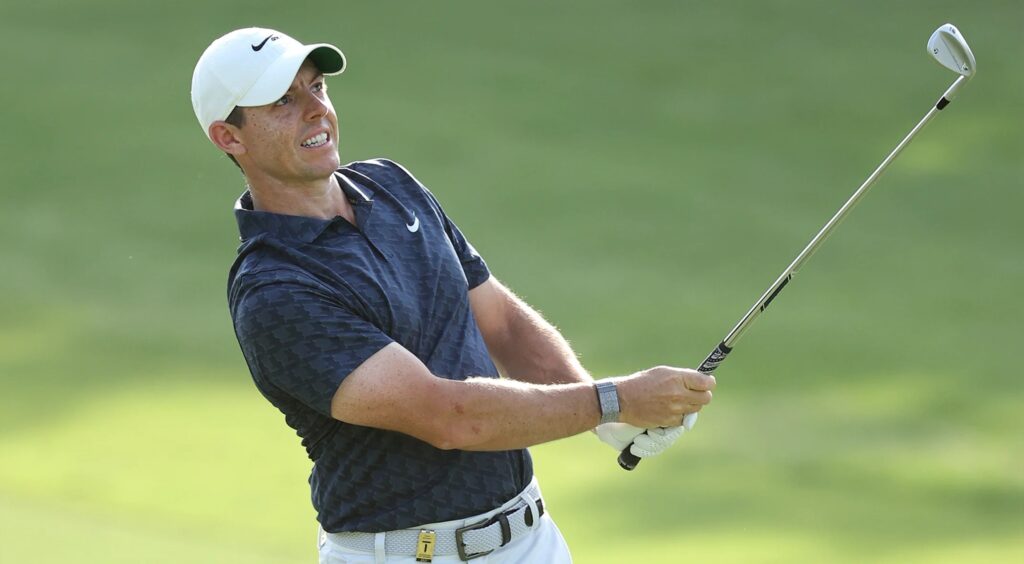
When you start planning for your next golf get away, take a look at the GolfDay Top 100 U.S. Resorts below. Tom Fazio, with original designs or updates for 20 of the Top 100 resorts, is the leading architect for laying out the very best resort courses. Not surprisingly, Jack Nicklaus (18) and Pete Dye (14) are right there as well.
Looking at magnificent course architecture from a family perspective, however, it’s hard to keep up with the Jones’s, as Robert Trent Jones, Sr., Rees Jones and RTJ II designed or updated 27 of the Top 100 resort courses in the country (including Robert Trent Jones’ ultimate gift–the RTJ Golf Trail).
Bill Coore and Ben Crenshaw have also sculpted many of the best resort courses in the U.S (7 in the Top 100—including Sheep Ranch, the latest addition to the wonderful courses at Bandon Dunes).
And speaking of Bandon, a special “thank you” has to go out to Tom Doak and David McLay Kidd for the spectacular layouts at Bandon Dunes, always #1 on the golf retreat bucket list (not to mention their work at Forest Dunes, Streamsong, Sand Valley and Gamble Sands).
The GolfDay Resort rating is based on a variety of criteria, including the stature of the architect(s) who did the original design(s), the variety of courses located at the property, updates that have been done on the course(s), USGA Course and Slope Ratings, current local and national rankings by Golf Digest and Golfweek, the quality and diversity of practice facilities, general course conditioning and current reviews, as well as the quality of accommodations and level of service.
Florida boasts the highest number of golf resorts in the Top 100 with 11 (including 7 in the top 50), followed closely by California with 8.
Wisconsin golf may well be the most spectacular of all with 7 in the Top 100 (4 in the top 50)—along with the amazing courses on the Wisconsin Golf Trail).
Michigan should also catch your attention when planning a trip as the weather starts to warm up in the Spring with 6 resorts in the Top 100 (4 in the Top 50).
Keep in mind that along with Bandon Dunes, the Pacific Northwest offers 5 additional resorts in the Top 100, so you may want to plan an extended stay.
For the best public courses, take a look at the GolfDay Top 500.

- Bandon Dunes/Bandon, OR
-
- Holes: 103 (5-Eighteen Hole Regulation Courses and Thirteen Hole Par 3)
- Course Architects: Tom Doak/David McLay Kidd/Jim Urbina/Bill Coore/Ben Crenshaw
- USGA Course/Slope Rating
- Pacific Dunes: 72.3/143
- Bandon Dunes: 76.3/141
- Old Macdonald: 74.4/134
- Bandon Trails: 73.6/130
- Sheep Ranch: 72.1/122
- Practice Facilities: 2 Grass Driving Ranges with Targets (North/South), Wedge Range, Putting and Chipping Greens with Bunkers and Expansive Putting Course (Punch Bowl).
- Accommodations
- Rankings: Golf Digest Top 100, Golf Digest Top 100-Public, Golfweek Top 200 Resorts, Golf Digest OR Top 15, Golfweek OR Top 10-Public
- GolfDay Rating: 100

- Pebble Beach Resorts/Pebble Beach, CA
- Holes: 81 (4-Eighteen Hole Regulation Courses and Eighteen Hole Par 3)
- Course Architects
- Pebble Beach: Jack Neville/Douglas Grant/William Herbert Fowler/Chandler Egan/Robert Hunter/Roger Lapham/Sandy Tatum/Ed Connor/Jack Nicklaus
- Spyglass Hill: Robert Trent Jones, Sr.
- Spanish Bay: Robert Trent Jones, Sr./Tom Watson/Sandy Tatum
- Del Monte: Charles Maud
- The Hay (Par 3): Peter Hay/Jack Neville/Robert McClure/Tiger Woods
- USGA Course/Slope Rating
- Pebble Beach: 74.9/144
- Spyglass Hill: 75.4/145
- Spanish Bay: 73.8/143
- Del Monte: 71.6/131
- Practice Driving Ranges with Targets, Putting and Chipping Greens with Bunkers (Pebble/Spyglass), Spanish Bay and Del Monte Golf Course-Putting and Chipping Greens
- Accommodations
- Rankings: Golf Digest Top 100, Golf Digest Top 100-Public, Golfweek Top 200 Resorts, Golf Digest CA Top 45, Golfweek CA Top 30-Public
- GolfDay Rating: 100

- Kiawah Island Golf Resort/Kiawah Island, SC
-
- Holes: 90 (5-Eighteen Hole Regulation Courses)
- Course Architects: Pete Dye/Alice Dye/Gary Player/Clyde Johnston/Tom Fazio/Jack Nicklaus
- USGA Course/Slope Rating
- Ocean: 79.1/155
- Cougar Point: 72.7/134
- Oak Point: 72.1/137
- Osprey Point: 73.6/140
- Turtle Point: 73.0/134
- Practice Facilities: Grass Driving Ranges with Targets, Chipping and Putting Greens at each course. Range Balls included with Greens Fee.
- Accommodations
- Rankings: Golf Digest Top 100, Golf Digest Top 100-Public, Golfweek Top 200 Resorts, Golf Digest SC Top 35, Golfweek SC Top 15-Public
- GolfDay Rating: 100

- Pinehurst Resort/Pinehurst, NC
-
- Holes: 162 (9-Eighteen Hole Regulation Courses)
- Course Architects: Donald Ross/Walter Travis/Richard Tufts/Tom Fazio/Tom Marzolf/Ellis Maples/George Fazio/Rees Jones/Jack Nicklaus
- USGA Course/Slope Rating
- #1: 68.4/118
- #2: 76.5/138
- #3: 66.1/123
- #4: 74.9/138
- #5: 73.1/135
- #6: 74.7/139
- #7: 75.5/143
- #8: 74.1/137
- #9: 74.8/143
- Practice Facilities: Grass Driving Range with Targets, Wedge Range and Multiple Chipping Greens with Bunkers, Thistle Dhu Putting Course.
- Accommodations
- Rankings: Golf Digest Top 100, Golf Digest Top 100-Public, Golfweek Top 200 Resorts, Golf Digest NC Top 30, Golfweek NC Top 15-Public
- GolfDay Rating: 100

- The American Club Hotel Resort/Sheboygan, WI
- Wisconsin Golf Trail
-
- Holes: 82 (4-Eighteen Hole Regulation Courses and 10 Hole Par 3)
- Course Architect: Pete Dye
- USGA Course/Slope Rating
- Straits (Whistling Straits): 77.2/152
- Irish (Whistling Straits): 75.6/146
- River: (Blackwolf Run) 76.2/151
- Meadow Valleys: (Blackwolf Run) 75.1/145
- Practice Facilities: Grass Driving Ranges with Targets, Putting and Chipping Greens with Bunkers. Range Balls included with Greens Fee.
- Accommodations
- Wisconsin Golf Trail
- Rankings: Golf Digest Top 100, Golf Digest Top 100-Public, Golfweek Top 200 Resorts Golf Digest WI Top 15, Golfweek WI Top 15-Public
- GolfDay Rating: 100

- Sea Island/Sea Island, GA
- Georgia Golf Trail
-
- Holes: 54 (3-Eighteen Hole Courses)
- Course Architects: Walter Travis/H. S. Colt/C. H. Alison/Robert Trent Jones, Sr./Dick Wilson/Joe Lee/Rocky Roquemore/Tom Fazio/Davis Love III/Mark Love/Rees Jones
- USGA Course/Slope Rating
- Plantation: 74.1/130
- Seaside: 74.2/141
- Retreat: 73.9/133
- Practice Facilities: Expansive Grass Driving Range with Targets, Putting and Chipping Greens with Bunkers and Performance Center with Club Fitting.
- Accommodations
- Georgia Golf Trail
- Rankings: Golf Digest Top 200, Golf Digest Top 100-Public, Golfweek Top 200 Resorts, Golf Digest GA Top 15, Golfweek GA Top 15-Public
- GolfDay Rating: 100

- Big Cedar Lodge/Ridgedale, MO
- Top of the Rock Preserve
-
- Holes: 76 (3-Eighteen Hole Regulation Courses, Thirteen Hole Executive Course and Nine Hole Par 3)
- Course Architects: Tom Fazio/Bill Coore/Ben Crenshaw/Tiger Woods/Gary Player/Jack Nicklaus
- USGA Course/Slope Rating
- Buffalo Ridge Springs: 73.4/130
- Ozarks National: 73.9/131
- Payne’s Valley: 75.6/132
- Top of the Rock: 27.7/85
- Practice Facilities: Grass Driving Range with Targets, Putting and Chipping Greens with Bunker.
- Accommodations
- Rankings: Golf Digest Top 200, Golf Digest Top 100-Public, Golfweek Top 200 Resorts, Golf Digest MO Top 10, Golfweek MO Top 10-Public
- GolfDay Rating: 100

- Reynolds Lake Oconee/Greensboro, GA
- Ritz Carlton/Georgia Golf Trail
-
- Holes: 99 (4-Eighteen Hole Regulation Courses and Twenty-Seven Hole Regulation Course)
- Course Architects: Jack Nicklaus/Tom Fazio/Rees Jones/Bob Cupp/Fuzzy Zoeller/Hubert Green
- USGA Course/Slope Rating
- Great Waters: 75.7/143
- National-Bluff: 37.0/143
- National-Cove: 37.4/143
- National-Ridge: 37.2/143
- Oconee: 75.2/141
- Landing: 74.5/138
- Preserve: 72.2/133
- Practice Facilities: Grass Driving Range with Targets, Putting and Chipping Greens with Bunker and TaylorMade Kingdom of Golf Academy.
- Accommodations
- Georgia Golf Trail
- Rankings: Golf Digest Top 100-Public, Golfweek Top 200 Resorts Golf Digest GA Top 30, Golfweek GA Top 15-Public
- GolfDay Rating: 100

- PGA West/La Quinta, CA
- Hilton Honors/La Quinta Resort & Club
-
- Holes: 54 (3-Eighteen Hole Courses)
- Course Architects: Greg Norman/Tad Burnett/Matthew Dusenberry/Jack Nicklaus/Pete Dye
- USGA Course/Slope Rating
- Norman: 74.6/141
- Nicklaus Resort: 75.3/143
- TPC Stadium: 75.8/148
- Practice Facilities: Grass Driving Range with Targets, Putting and Chipping Greens with Bunkers and Golf Academy.
- Accommodations
- Rankings: Golf Digest Top 100-Public, Golfweek Top 200 Resorts, Golf Digest CA Top 45, Golfweek CA Top 30-Public
- GolfDay Rating: 100

- The Greenbrier/White Sulphur Springs, WV
-
- Holes: 81 (4-Eighteen Hole Regulation Courses Nine Hole Par 3)
- Course Architects: C. B. Macdonald/Seth Raynor/George O’Neil/Jack Nicklaus/Dick Wilson/Bob Cupp/Tom Fazio/Keith Foster/Kevin Hargrave
- USGA Course/Slope Rating
- Old White: 76.0/145
- Greenbrier: 73,0/137
- Meadows: 72.0/138
- Snead: 74.7/138
- Practice Facilities: Grass Driving Range with Targets, Putting and Chipping Greens with Bunker.
- Accommodations
- Rankings: Golf Digest Top 200, Golf Digest Top 100-Public, Golfweek Top 200 Resorts, Golf Digest WV Top 10, Golfweek WV Top 5-Public
- GolfDay Rating: 100

- French Lick Resort/French Lick, IN
- Pete Dye Golf Trail
-
- Holes: 45 (2-Eighteen Hole Courses and Nine Hole Regulation Course)
- Course Architects: Tom Bendelow/Hal Purdy/Pete Dye/Donald Ross/Sandy Alves/Allan MacCurrach
- USGA Course/Slope Rating
- Dye: 80.5/151
- Ross: 75.7/149
- Valley Links: 35.4/121
- Practice Facilities: Grass Driving Range with Targets (Dye and Valley Links), Putting and Chipping Greens with Bunker. Warm Up Net with Putting and Chipping Green (Ross).
- Accommodations
- Pete Dye Golf Trail
- Rankings: Golf Digest Top 200, Golf Digest Top 100-Public, Golfweek Top 200 Resorts, Golf Digest IN Top 15, Golfweek IN Top 10-Public
- GolfDay Rating: 100

https://www.usatoday.com/
- Streamsong Resort/Bowling Green, FL
-
- Holes: 54 (3-Eighteen Hole Regulation Courses)
- Course Architects: Tom Doak/Bill Coore/Ben Crenshaw/Gil Hanse
- USGA Course/Slope Rating
- Blue: 74.0/134
- Red: 74.1/137
- Black: 74.7/135
- Practice Facilities: Grass Driving Range with Targets and Fairway Bunker, Putting and Chipping Greens with Bunker.
- Accommodations
- Rankings: Golf Digest Top 200, Golf Digest Top 100-Public, Golfweek Top 200 Resorts, Golf Digest FL Top 45, Golfweek FL Top 30-Public
- GolfDay Rating: 100

- The Sea Pines Resort/Hilton Head Island, SC
-
- Holes: 54 (3-Eighteen Hole Regulation Courses)
- Course Architects: Pete Dye/Jack Nicklaus/George Cobb/Clyde Johnston/Davis Love III/Scot Sherman
- USGA Course/Slope Rating
- Harbour Town Links: 75.6/148
- Heron Point: 74.8/140
- Atlantic Dunes: 74.3/143
- Practice Facilities: Grass Driving Ranges with Targets (Harbour Town and Heron Point/Ocean), Putting and Chipping Greens with Bunkers. Range Balls and Fore Caddie (Harbour Town) included with Greens Fee.
- Accommodations
- Rankings: Golf Digest Top 200, Golf Digest Top 100-Public, Golfweek Top 200 Resorts, Golf Digest SC Top 35, Golfweek SC Top 15-Public
- GolfDay Rating: 100

- Barefoot Resort & Golf/North Myrtle Beach, SC
-
- Holes: 72 (4-Eighteen Hole Regulation Courses)
- Course Architects: Greg Norman/Tad Burnett/Davis Love III/Tom Fazio/Pete Dye Moreau/David Gill/Mike DeVries
- USGA Course/Slope Rating
- Norman: 74.2/141
- Love: 74.9/141
- Fazio: 73.4/144
- Dye: 76.0/143
- Practice Facilities: Lighted and Covered Grass Driving Range with Targets, Putting and Chipping Greens with Bunker. Dyer and Greg Norman Golf Academies.
- Accommodations
- Rankings: Golfweek Top 200 Resorts, Golf Digest SC Top 35, Golfweek SC Top 15-Public
- GolfDay Rating: 100

- Turning Stone/Verona, NY
-
- Holes: 63 (3-Eighteen Hole Regulation Courses and Nine Hole Regulation Course)
- Course Architects: Tom Fazio/Robert Trent Jones, Jr./Ty Butler/Edward Peters/Rick Smith
- USGA Course/Slope Rating
- Atunyote: 75.7/135
- Kaluhyat: 75.2/145
- Shenendoah: 74.2/140
- Pleasant Knolls: 35.5/119
- Practice Facilities: Grass Driving Range with Targets and Fairway Bunker (Atunyote/Shenendoah). Grass Driving Range with Targets (Kaluhyat). Putting and Chipping Greens with Bunker (Atunyote/Shenendoah and Kaluhyat). Domed Indoor facility with two-tiered hitting stations, Putting and Chipping Greens with Bunker. Performance Center with Club Fitting and Golf Academy.
- Accommodations
- Rankings: Golfweek Top 200 Resorts, Golf Digest NY Top 40, Golfweek NY Top 15-Public
- GolfDay Rating: 100

- Trump National Doral/Miami, FL
-
- Holes: 72 (4-Eighteen Hole Regulation Courses)
- Course Architects: Dick Wilson/Gil Hanse/Greg Norman/Raymond Floyd/Jerry Pate
- USGA Course/Slope Rating
- Blue Monster: 77.4/146
- Red Tiger: 71.8/136
- Silver Fox: 74.9/148
- Golden Palm: 74.2/139
- Practice Facilities: Expansive Lighted Grass Driving Range with Targets, Putting and Chipping Greens with Bunkers and Rick Smith Golf School.
- Accommodations
- Rankings: Golf Digest Top 100-Public, Golfweek Top 200 Resorts, Golf Digest FL Top 45, Golfweek FL Top 30-Public
- GolfDay Rating: 100

- TPC Sawgrass/Ponte Vedra Beach, FL
-
- Holes: 36 (2-Eighteen Hole Regulation Courses)
- Course Architects: Pete Dye/Alice Dye/Jerry Pate/Steve/Wenzloff/Bobby Weed
- USGA Course/Slope Rating
- Stadium: 76.4/155
- Dye’s Valley: 74.0/134
- Practice Facilities: Grass Driving Range, Putting and Chipping Greens with Bunkers and Tour Academy.
- Accommodations
- Rankings: Golf Digest Top 100, Golf Digest Top 100-Public, Golfweek Top 200 Resorts, Golf Digest FL Top 45, Golfweek FL Top 30 Public
- GolfDay Rating: 100

- Pine Needles Lodge and Golf Club /Southern Pines, NC
-
- Holes: 36 (2-Eighteen Hole Courses)
- Course Architects: Donald Ross/John Fought/Kyle Franz
- USGA Course/Slope Rating
- Pine Needles: 73.9/134
- Mid Pines: 71.7/130
- Practice Facilities: Grass Driving Range with Targets and Fairway Bunker, Putting and Chipping Greens with Bunker.
- Accommodations
- Rankings: Golf Digest Top 100, Golf Digest Top 100-Public, Golfweek Top 200 Resorts, Golf Digest NC Top 45, Golfweek NC Top 15 Public
- GolfDay Rating: 100

- Shadow Creek Golf Club/Las Vegas, NV
- MGM Resorts
-
- Holes: 18
- Course Architects: Tom Fazio
- Par 72/7,560 Yards from Championship Tees (Not Rated by USGA)
- Practice Facilities: Grass Driving Range with Targets, Putting and Chipping Greens.
- Accommodations
- Rankings: Golf Digest Golf Digest Top 100, Golf Digest Top 100-Public, Golfweek Top 200 Resorts, Golf Digest NV Top 15, Golfweek NV Top 15 Public
- GolfDay Rating: 100

- PGA Village/Port St. Lucie, FL
-
- Holes: 70 (3-Eighteen Hole Regulation Courses and 6 Hole Par 3)
- Course Architects: Tom Fazio/Pete Dye
- USGA Course/Slope Rating
- Wanamaker 75.2/134
- Dye: 75.7/142
- Ryder: 73.2/133
- Practice Facilities: Extensive including Lighted Grass Range with Targets, Wedge Range, Putting Greens, Chipping Greens with Multiple Bunkers and PGA Golf School.
- Accommodations
- Rankings: Golfweek Top 200 Resorts, Golfweek FL Top 30-Public
- GolfDay Rating: 100

- Red Sky Ranch/Wolcott, CO
-
- Holes: 36 (2-Eighteen Hole Regulation Courses)
- Course Architects: Greg Norman/Matthew Dusenberry/Tom Fazio
- USGA Course/Slope Rating
- Norman: 74.6/147
- Fazio: 72.3/141
- Practice Facilities: Double Ended Grass Driving Range with Targets, Putting and Chipping Greens with Bunker and Larry Rinker Golf Academy.
- Accommodations
- Rankings: Golf Digest Top 100-Public, Golfweek Top 200 Resorts, Golf Digest CO Top 15, Golfweek CO Top 10 Public
- GolfDay Rating: 100

- Forest Dunes/Roscommon, MI
-
- Holes: 36 (2-Eighteen Hole Courses. The Loop offers 2 Layouts-Black/Red)
- Course Architects: Tom Weiskopf/Tom Doak
- USGA Course/Slope Rating
- Forest Dunes: 75.2/146
- Loop-Black: 71.7/125
- Loop-Red: 71.9/124
- Practice Facilities: Grass Driving Range with Targets, Putting and Chipping Greens with Bunker.
- Accommodations
- Rankings: Golf Digest Top 200, Golf Digest Top 100-Public, Golfweek Top 200 Resorts, Golf Digest MI Top 30, Golfweek MI Top 20-Public
- GolfDay Rating: 100

- Pronghorn/Bend, OR
- Juniper Preserve
-
- Holes: 36 (2-Eighteen Hole Regulation Courses)
- Course Architects: Jack Nicklaus/Tom Fazio
- USGA Course/Slope Rating
- Nicklaus: 75.0/148
- Fazio: 74.8/141
- Practice Facilities: Grass Driving Range with Targets, Putting and Chipping Greens with Bunker.
- Accommodations
- Rankings: Golf Digest Top 200, Golf Digest Top 100-Public, Golfweek Top 200 Resorts, Golf Digest OR Top 15, Golfweek OR Top 10-Public
- GolfDay Rating: 100

- PGA National Resort/Palm Beach Gardens, FL
-
- Holes: 90 (5-Eighteen Hole Regulation Courses)
- Course Architects: Tom Fazio/Jack Nicklaus/Arnold Palmer/Ed Seay/George Fazio/Karl Litten/Andy Staples
- USGA Course/Slope Rating
- Champion: 75.4/144
- Palmer: 74.7/142
- Fazio: 74.4/138
- Squire: 72.2/137
- Estate: 72.6/138
- Practice Facilities: Double Sided Grass Driving Range with Targets, Wedge Range, Putting and Chipping Greens with Bunkers, Leadbetter Academy and Pelz Golf School.
- Accommodations
- Rankings: Golfweek Top 200 Resorts, Golf Digest FL Top 45, Golfweek FL Top 30-Public
- GolfDay Rating: 99.6

- Sand Valley Golf Resort/Nekoosa, WI
- Wisconsin Golf Trail
-
- Holes: 53 (2-Eighteen Hole Regulation Course and Seventeen Hole Par 3)
- Course Architects: David McLay Kidd/Bill Coore/Ben Crenshaw
- USGA Course/Slope Rating
- Mammoth Dunes: 75.1/137
- Sand Valley: 74.7/135
- Practice Facilities: Grass Driving Ranges (2) with Targets, Putting and Chipping Greens with Bunkers (5). Range Balls included with Greens Fee.
- Accommodations
- Wisconsin Golf Trail
- Rankings: Golf Digest Top 200, Golf Digest Top 100-Public, Golfweek Top 200 Resorts, Golf Digest OR Top 15, Golfweek OR Top 10-Public
- GolfDay Rating: 99.5

- The Broadmoor/Colorado Springs, CO
-
- Holes: 54 (3-Eighteen Hole Courses/Mountain Course Closed for Renovation)
- Course Architects: Donald Ross/Robert Trent Jones, Sr./Jack Nicklaus/Ron Forse
- USGA Course/Slope Rating
- East: 72.7/139
- West: 71.8/134
- Practice Facilities: Grass Driving Range with Targets, Putting and Chipping Greens with Bunkers.
- Accommodations
- Rankings: Golf Digest Top 200, Golf Digest Top 100-Public, Golfweek Top 200 Resorts, Golf Digest CO Top 15, Golfweek CO Top 10-Public
- GolfDay Rating: 98.8

- Kapalua Resort/Lahaina, HI
-
- Holes: 36 (2-Eighteen Hole Regulation Courses)
- Course Architects: Arnold Palmer/Francis Duane/Hale Irwin/Robin Nelson/Rodney Wright/Neil Haworth/Bill Coore/Ben Crenshaw
- USGA Course/Slope Rating
- Bay: 72.7/137
- Plantation: 73.5/147
- Practice Facilities: Grass Driving Range with Targets, Putting and Chipping Greens with Bunker and Golf Academy.
- Accommodations
- Rankings: Golf Digest Top 200, Golf Digest Top 100-Public, Golfweek Top 200 Resorts, Golf Digest HI Top 15, Golfweek HI Top 15-Public
- GolfDay Rating: 98.7

- Nemacolin/Farmington, PA
-
- Holes: 36 (2-Eighteen Hole Regulation Courses)
- Course Architects: Pete Dye/Tim Liddy
- USGA Course/Slope Rating
- Mystic Rock: 77.2/146
- Shepherd’s rock: 75.2/140
- Practice Facilities: Grass Driving Range with TrackMan Technology, Putting and Chipping Greens with Bunker. Range Balls included with Greens Fee.
- Accommodations
- Rankings: Golf Digest Top 100-Public, Golfweek Top 200 Resorts, Golf Digest PA Top 30, Golfweek PA Top 10-Public
- GolfDay Rating: 98.5

- Barton Creek/Austin, TX
- Omni Resorts
-
- Holes: 72 (4-Eighteen Hole Regulation Courses)
- Course Architects: Tom Fazio/Bill Coore/Ben Crenshaw/Arnold Palmer
- USGA Course/Slope Rating
- Canyons: 74.4/144
- Foothills: 75.3/141
- Cliffside: 72.6/133
- Lakeside: 72.4/140
- Practice Facilities: Grass Driving Range with Targets, Putting and Chipping Greens with Bunker. Additional Grass Range with Targets and Short Game facility at Fazio Course.
- Accommodations
- Rankings: Golfweek Top 200 Resorts, Golf Digest TX Top 30, Golfweek TX Top 20-Public
- GolfDay Rating: 98.4

- Sunriver Resort/Sunriver, OR
-
- Holes: 63 (3-Eighteen Hole Regulation Courses and 9 Hole Par 3)
- Course Architects: John Fought/Robert Trent Jones, Jr./Jim Ramey/Bob Cupp
- Crosswater: 76.8/147
- Meadows: 73.7/143
- Woodlands: 73.9/144
- Practice Facilities: Grass Driving Range with Targets, Putting and Chipping Greens with Bunker and Indoor Golf Simulators. Range Balls included with Greens Fee.
- Accommodations
- Rankings: Golf Digest Top 100-Public, Golfweek Top 200 Resorts, Golf Digest OR Top 15, Golfweek OR Top 10-Public
- GolfDay Rating: 98.4

- SentryWorld/Stevens Point, WI
- The Inn at SentryWorld/Wisconsin Golf Trail
-
- Holes: 18
- Course Architects: Robert Trent Jones, Jr./Bruce Charlton/Jay Blasi
- USGA Course/Slope Rating: 6/151
- Practice Facilities: Grass Driving Range with Targets and Fairway Bunker, Warm-up Tee, Wedge Range, Putting and Chipping Greens with Bunkers.
- Accommodations
- Wisconsin Golf Trail
- Rankings: Golf Digest Top 100-Public, Golfweek Top 200 Resorts, Golf Digest WI Top 15, Golfweek WI Top 15-Public
- GolfDay Rating: 98.4

- Grand National/Opelika, AL
- Auburn Marriott Opelika Resort & Spa/Robert Trent Jones Golf Trail
-
- Holes: 54 (2-Eighteen Hole Regulation Courses and Eighteen Par 3)
- Course Architects: Robert Trent Jones, Sr./Roger Rulewich
- USGA Course/Slope Rating
- Links: 75.2/142
- Lake: 73.9/132
- Practice Facilities: Grass Driving Range with Targets, Putting and Chipping Greens with Bunker.
- Accommodations
- RTJ Golf Trail
- Rankings: Golfweek Top 200 Resorts, Golf Digest AL Top 10, Golfweek AL Top 10-Public
- GolfDay Rating: 98.1

- Erin Hills/Erin, WI
- Wisconsin Golf Trail
-
- Holes: 18
- Course Architects: Michael Hurdzan/Dana Fry/Ron Whitten
- USGA Course/Slope Rating: 9/145
- Practice Facilities: Grass Driving Range with Targets, Fairway Bunkers and TopTracer Technology. Putting and Chipping Greens with Bunkers and Lighted Drumlin Putting Course. TaylorMade Range Balls included with Greens Fee.
- Accommodations
- Wisconsin Golf Trail
- Rankings: Golf Digest Top 100-Public, Golfweek Top 200 Resorts, Golf Digest WI Top 15, Golfweek WI Top 15-Public
- GolfDay Rating: 98.0

- Paiute Golf Resort/Las Vegas, NV
-
- Holes: 54 (3-Eighteen Hole Courses)
- Course Architects: Pete Dye
- USGA Course/Slope Rating
- Wolf: 75.5/145
- Snow Mountain: 73.1/130
- Sun Mountain: 73.0/135
- Practice Facilities: Grass Driving Ranges (2) with Targets, Putting and Chipping Greens with Bunkers
- Accommodations
- Rankings: Golfweek Top 200 Resorts, Golf Digest NV Top 15, Golfweek NV Top 15-Public
- GolfDay Rating: 97.8

- Ventana Canyon Golf & Racquet Club/Tucson, AZ
- Ventana Canyon Blub and Lodge
-
- Holes: 36 (2-Eighteen Hole Regulation Courses)
- Course Architects: Tom Fazio
- USGA Course/Slope Rating
- Canyon: 71.7/137
- Mountain: 72.8/143
- Practice Grass Driving Range with Targets, Putting and Chipping Greens with Bunkers. Range Balls included with Greens Fee.
- Accommodations
- Rankings: Golfweek Top 200 Resorts, Golf Digest AZ Top 35, Golfweek AZ Top 30-Public
- GolfDay Rating: 97.7

- Arcadia Bluffs Golf Club/Arcadia, MI
-
- Holes: 36 (2-Eighteen Hole Regulation Courses)
- Course Architects: Warren Henderson/Rick Smith/Dana Fry/Jason Straka
- USGA Course/Slope Rating
- Bluffs: 75.7/146
- South: 75.6/132
- Practice Facilities: Grass Driving Range with Targets, Putting and Chipping Greens with Bunkers (at both locations). Range Balls included with Greens Fee.
- Accommodations
- Rankings: Golf Digest Top 100-Public, Golfweek Top 200 Resorts, Golf Digest MI Top 30, Golfweek MI Top 20-Public
- GolfDay Rating: 97.5

- Kingsmill Resort/Williamsburg, VA
-
- Holes: 54 (3-Eighteen Hole Regulation Courses)
- Course Architects: Pete Dye/Arnold Palmer/Ed Seay/Edmund Ault/Brian Ault/Tom Clark/Curtis Strange
- USGA Course/Slope Rating
- River: 73.2/136
- Plantation: 70.9/130
- Woods: 72.2/133
- Practice Facilities: Driving Range with Targets and Fairway Bunker (Grass Thursday-Sunday, Mats Monday-Wednesday), Putting and Chipping Greens with Bunkers. Range Balls included with Greens Fee.
- Accommodations
- Rankings: Golf Digest Top 100-Public, Golfweek Top 200 Resorts, Golf Digest VA Top 20, Golfweek VA Top 15-Public
- GolfDay Rating: 97.4

- The Highlands at Harbor Springs/Harbor Springs, MI
- Boyne Golf
-
- Holes: 81 (4-Eighteen Hole Regulation Courses and Nine Hole Par 3)
- Course Architects: Robert Trent Jones, Sr./Arthur Hills/William Newcomb/Everett Kircher/Stephen Kircher/Jim Flick/Mike DeVries
- USGA Course/Slope Rating
- Heather: 75.4/147
- Hills: 75.4/144
- Moor: 73.5/144
- Ross Memorial: 73.9/143
- Practice Facilities: Grass Driving Ranges with Targets (2), Putting and Chipping Greens with Bunker. Golf Academy with GEARS 3-D Body and Club Tracking System and Junior Golf Program. Range Balls included with Greens Fee.
- Accommodations
- Rankings: Golfweek Top 200 Resorts, Golf Digest MI Top 30, Golfweek MI Top 20-Public
- GolfDay Rating: 97.3

- We-Ko-Pa Golf Club/Fort McDowell, AZ
- We-Ko-Pa Casino Resort
-
- Holes: 36 (2-Eighteen Hole Regulation Courses)
- Course Architects: Scott Miller/Bill Coore/Ben Crenshaw
- USGA Course/Slope Rating
- Cholla: 73.4/138
- Saguaro: 72.0/137
- Practice Facilities: Expansive Grass Driving Range with Targets, Putting and Chipping Greens with Bunker.
- Accommodations
- Rankings: Golfweek Top 200 Resorts, Golf Digest AZ Top 35, Golfweek AZ Top 30-Public
- GolfDay Rating: 97.1

- Horseshoe Bay Resort/Horseshoe Bay, TX
-
- Holes: 54 (3-Eighteen Hole Courses)
- Course Architects: Robert Trent Jones, Sr./Roger Rulewich/Jack Nicklaus
- USGA Course/Slope Rating
- Slick Rock: 73.2/134
- Ram Rock: 75.2/139
- Apple Rock: 74.6/140
- Practice Facilities: 2 Grass Driving Ranges with Targets, Putting and Chipping Green (Apple Rock/Ram Rock and Slick Rock) with Eighteen Hole Natural Grass Miniature Golf Course.
- Accommodations
- Rankings: Golf Digest TX Top 30
- GolfDay Rating: 97.0

- Treetops Resort/Gaylord, MI
-
- Holes: 81 (4-Eighteen Hole Regulation Courses and Nine Hole Par 3)
- Course Architects: Robert Trent Jones, Sr./Tom Fazio/Rick Smith
- USGA Course/Slope Rating
- Masterpiece: 74.8/147
- Premier: 73.3/139
- Signature: 72.9/140
- Tradition: 70.0/130
- Practice Facilities: 2 Grass Driving Ranges with Targets (Masterpiece and Treetops North), Putting and Chipping Greens with Bunkers (both facilities). Range Balls included with Greens Fee.
- Accommodations
- Junior Golf
- Rankings: Golfweek Top 200 Resorts, Golfweek MI Top 30-Public
- GolfDay Rating: 97.0

- The Prairie Club/Valentine, NE
-
- Holes: 46 (2-Eighteen Regulation Hole Courses and Ten Hole Par 3)
- Course Architects: Tom Lehman/Chris Brands/Graham Marsh/Gil Hanse/Geoff Shackelford
- USGA Course/Slope Rating
- Dunes: 75.5/133
- Pines: 74.6/129
- Practice Facilities: Double Ended Grass Driving Range with Targets, Putting and Chipping Greens with Bunker.
- Accommodations
- Rankings: Golf Digest Top 100-Public, Golfweek Top 200 Resorts, Golf Digest NE Top 10, Golfweek NE Top 5-Public
- GolfDay Rating: 96.8

- The Homestead/Hot Springs, VA
- Omni Hotels & Resorts
-
- Holes: 36 (2-Eighteen Hole Courses)
- Course Architects: Donald Ross/William Flynn/Tom Clark/Bill Love
- USGA Course/Slope Rating
- Cascades: 72.9/135
- Old Course: 69.6/128
- Practice Facilities: Grass Driving Range with Targets, Putting and Chipping Greens with Bunker (at both Cascades and Old Course).
- Accommodations
- Rankings: Golf Digest Top 200, Golf Digest Top 100-Public, Golf Digest VA Top 20, Golfweek VA Top 15-Public
- GolfDay Rating: 96.7

- Fallen Oak Golf Club/Saucier, MS
- Beau Rivage/Mississippi Golf Trail
-
- Holes: 18
- Course Architects: Tom Fazio
- USGA Course/Slope Rating: 5/142
- Practice Facilities: Grass Driving Range, Putting and Chipping Greens with Bunker.
- Accommodations
- Mississippi Golf Trail
- Rankings: Golf Digest Top 100-Public, Golfweek Top 200 Resorts, Golf Digest MS Top 10, Golfweek MS Top 10-Public
- GolfDay Rating: 96.6

- Capitol Hill/Prattville, AL
- Montgomery Marriott/Robert Trent Jones Golf Trail
-
- Holes: 54 (3-Eighteen Hole Regulation Courses)
- Course Architects: Robert Trent Jones, Sr./Roger Rulewich
- USGA Course/Slope Rating
- Judge: 78.5/147
- Legislator: 76.9/149
- Senator: 77.4/132
- Practice Facilities: Grass Driving Range with Targets, Putting and Chipping Greens with Bunker.
- Accommodations
- RTJ Golf Trail
- Rankings: Golf Digest AL Top 10, Golfweek AL Top 10-Public
- GolfDay Rating: 96.5

- Burnt Pine Golf Club/Miramar Beach, FL
- Sandestin Golf and Beach Resort
-
- Holes: 18
- Course Architects: Rees Jones
- USGA Course/Slope Rating: 8/148
- Practice Facilities: Grass Driving Range, Putting and Chipping Greens with Bunker.
- Accommodations
- Rankings: Golfweek Top 200 Resorts, Golfweek FL Top 30-Public
- GolfDay Rating: 96.4

- Mauna Kea Beach Hotel/Kohala Coast, HI
- Prince Resorts
-
- Holes: 18
- Course Architects: Robert Trent Jones, Sr./Rees Jones/Neil Haworth
- USGA Course/Slope Rating: 6/144
- Practice Facilities: Grass Driving Range with Targets, Putting and Chipping Greens with Bunker. Range Balls included with Greens Fee.
- Accommodations
- Rankings: Golf Digest Top 200, Golf Digest Top 100-Public, Golfweek Top 200 Resorts, Golf Digest HI Top 15, Golfweek HI Top 15-Public
- GolfDay Rating: 96.3

- Rio Secco Golf Club/Henderson, NV
- Caesars Palace Las Vegas
-
- Holes: 18
- Course Architects: Rees Jones
- USGA Course/Slope Rating: 7/140
- Practice Facilities: Driving Range with Targets, Putting and Chipping Greens with Butch Harmon School of Golf. Range Balls included with Greens Fee.
- Accommodations
- Rankings: Golfweek Top 200 Resorts, Golfweek NV Top 15-Public
- GolfDay Rating: 96.2

- Wailea Golf Club/Wailea, HI
- Wailea Resort
-
- Holes: 54
- Course Architects: Robert Trent Jones, Jr./Arthur Jack Snyder
- USGA Course/Slope Rating:
- Gold: 74.5/138
- Emerald: 72.8/135
- Blue: 71.6/139
- Practice Facilities: Grass Driving with Targets, Putting and Chipping Greens with Bunker.
- Accommodations
- Rankings: Golfweek Top 200 Resorts, Golf Digest HI Top 15 Golfweek HI Top 15-Public
- GolfDay Rating: 96.2

- Hammock Beach Resort/Palm Coast, FL
-
- Holes: 36 (2-Eighteen Hole Courses)
- Course Architects: Jack Nicklaus/Tom Watson
- USGA Course/Slope Rating
- Conservatory: 77.5/144
- Ocean: 75.1/141
- Practice Facilities: Driving Range, Putting and Chipping Greens.
- Accommodations
- Rankings: Golfweek Top 200 Resorts, Golf Digest FL Top 45, Golfweek FL Top 30-Public
- GolfDay Rating: 96.2

- Ross Bridge/Hoover, AL
- Robert Trent Jones Golf Trail
-
- Holes: 18
- Course Architects: Roger Rulewich/Bobby Vaughn
- USGA Course/Slope Rating: 78.4/147
- Practice Facilities: Grass Driving Range with Targets, Putting and Chipping Greens with Bunker.
- Accommodations
- RTJ Golf Trail
- Rankings: Golfweek AL Top 10-Public
- GolfDay Rating: 96.1

- Golden Horseshoe Golf Club/Williamsburg, VA
- Colonial Williamsburg Resorts
-
- Holes: 45 (2-Eighteen Hole Regulation Courses and Nine Hole Executive Course)
- Course Architects: Robert Trent Jones, Sr./Rees Jones/Greg Muirhead
- USGA Course/Slope Rating
- Gold: 73.4/140
- Green: 74.9/144
- Spotswood: 29.7/100
- Practice Facilities: Grass Driving Range, Putting and Chipping Greens with Bunker.
- Accommodations
- Rankings: Golfweek Top 200 Resorts, Golf Digest VA Top 20, Golfweek VA Top 15-Public
- GolfDay Rating: 96.0

- Bay Hill Club & Lodge/Orlando, FL
-
- Holes: 27 (3-Nine Hole Regulation Courses)
- Course Architects: Dick Wilson/Joe Lee/Bob Simmons/Arnold Palmer
- USGA Course/Slope Rating
- Champion: 37.9/142
- Challenger: 38.5/133
- Charger: 35.3/129
- Practice Facilities: Expansive Grass Driving Range, Putting and Chipping Greens with Bunker and Golf Academy.
- Accommodations
- Rankings: Golfweek Top 200 Resorts, Golf Digest FL Top 45, Golfweek FL Top 30-Public
- GolfDay Rating: 95.6

- Bay Harbor/Bay Harbor, MI
- Boyne Golf
-
- Holes: 27 (3-Nine Hole Regulation Courses)
- Course Architects: Arthur Hills/Stephen Kircher
- USGA Course/Slope Rating
- Links: 37.2/141
- Quarry: 37.1/150
- Preserve: 36.4/142
- Practice Facilities: Grass Driving Range with Targets, Putting and Chipping Green with Bunker. Range Balls included with Greens Fee.
- Accommodations
- Rankings: Golf Digest Top 100-Public, Golfweek Top 200 Resorts, Golf Digest MI Top 30, Golfweek MI Top 20-Public
- GolfDay Rating: 95.5

- The Course at McLemore/Rising Fawn, GA
-
- Holes: 24 (Eighteen Hole Regulation Courses and Six Hole Par 3)
- Course Architects: Rees Jones/Bill Bergin
- USGA Course/Slope Rating: 74/140
- Practice Facilities: Driving Range, Putting and Chipping Greens.
- Accommodations
- Rankings: Golf Digest Top 100-Public, Golfweek Top 200 Resorts, Golf Digest GA Top 30, Golfweek GA Top 15-Public
- GolfDay Rating: 95.5

- Troon North/Scottsdale, AZ
- Four Seasons
-
- Holes: 36 (2-Eighteen Hole Regulation Courses)
- Course Architects: Tom Weiskopf/Jay Morrish/Phil Smith
- USGA Course/Slope Rating
- Monument: 73.3/148
- Pinnacle: 73.2/147
- Practice Facilities: Grass Driving Range with Targets, Putting and Chipping Greens.
- Accommodations
- Performance Center
- Rankings: Golfweek Top 200 Resorts, Golf Digest AZ Top 35, Golfweek AZ Top 30-Public
- GolfDay Rating: 95.4

- Edgewood Tahoe Golf Course/Lake Tahoe, NV
- Edgewood Tahoe Resort
-
- Holes: 18
- Course Architects: George Fazio/Ronald Fream/Peter Thomson/Michael Wolveridge/Tom Fazio
- USGA Course/Slope Rating: 75.5/145
- Practice Facilities: Grass Driving Range with Targets, Putting and Chipping Greens with Bunker. Range Balls included with Greens Fee.
- Accommodations
- Rankings: Golf Digest Top 100-Public, Golf Digest NV Top 15, Golfweek NV Top 15-Public
- GolfDay Rating: 95.2

- The Golf Club of Mississippi/West Point, MS
-
- Holes: 36 (2-Eighteen Hole Regulation Courses)
- Course Architects: Gil Hanse/Bob Cupp/Jerry Pate
- USGA Course/Slope Rating:
- Mossy Oak: 74.3/136
- Old Waverly: 74.7/144
- Practice Facilities: Grass Driving Range with Target Greens, Putting and Chipping Greens.
- Accommodations
- Junior Golf
- Rankings: Golf Digest Top 100-Public, Golfweek Top 200 Resorts, Golf Digest MS Top 10, Golfweek MS Top 10-Public
- GolfDay Rating: 95.2

https://www.luxurytravelmagazine.com/
- The Highland Course/Meadows of Dan, VA
- Primland Resort
-
- Holes: 18
- Course Architects: Donald Steel
- USGA Course/Slope Rating: 75.1/150
- Practice Facilities: Grass Driving Range with Targets, Putting and Chipping Greens with Bunker.
- Accommodations
- Rankings: Golf Digest Top 200, Golf Digest Top 100-Public, Golfweek Top 200 Resorts, Golf Digest VA Top 20, Golfweek VA Top 15-Public
- GolfDay Rating: 95.1

- Silverado Resort & Spa/Napa, CA
- Wyndham/Dolce Resorts and Resorts
-
- Holes: 36 (2-Eighteen Hole Regulation Courses)
- Course Architects: Ben Harmon/John Dawson/Robert Trent Jones, Sr./Robert Muir Graves/Johnny Miller
- USGA Course/Slope Rating
- North: 74.8/141
- South: 72.3/133
- Practice Facilities: Grass Driving Range with Targets, Putting and Chipping Greens with Bunker.
- Accommodations
- Junior Golf
- Rankings: Golfweek Top 200 Resorts
- GolfDay Rating: 95.1

- Wilderness Club/Eureka, MT
- Wilderness Resort
-
- Holes: 18
- Course Architects: Lee Schmidt/Brian Curley/Nick Faldo
- USGA Course/Slope Rating: 75.4/154
- Practice Facilities: Grass Driving Range with Targets, Putting and Chipping Greens with Bunker. Range Balls included with Greens Fee.
- Accommodations
- Rankings: Golf Digest Top 100-Public, Golfweek Top 200 Resorts, Golf Digest MT Top 10, Golfweek MT Top 5-Public
- GolfDay Rating: 95.0

- Pelican Hill Golf Club/Newport Beach, CA
- The Resort at Pelican Hill
-
- Holes: 36 (2-Eighteen Hole Regulation Courses)
- Course Architect: Tom Fazio
- USGA Course/Slope Rating
- Ocean North: 73.5/137
- Ocean Souths: 72.0/133
- Practice Facilities: Grass Driving Range with Targets and Putting Green.
- Accommodations
- Golf Academy
- Rankings: Golfweek Top 200 Resorts, Golf Digest CA Top 45, Golfweek CA Top 30-Public
- GolfDay Rating: 94.8

- Tetherow Golf Club/Bend, OR
- Tetherow Resort
-
- Holes: 36 (2 Eighteen Hole Regulation Courses)
- Course Architect: David McLay Kidd
- USGA Course/Slope Rating
- Firecliff: 74.1/141
- Mountain View: 73.0/132
- Practice Facilities: Grass Driving Range with Targets, Wedge Range, Chipping and Putting Greens with Bunker. Range Balls included with Greens Fee.
- Accommodations
- Rankings: Golf Digest Top 100-Public, Golfweek Top 200 Resorts, Golf Digest OR-Top 15, Golfweek OR Top 15-Public
- GolfDay Rating: 92.7

https://www.quintessentialgolf.com/
- Giants Ridge/Biwabik, MN
-
- Holes: 36 (2-Eighteen Hole Regulation Courses)
- Course Architects: Jeffrey Brauer/Lanny Wadkins
- USGA Course/Slope Rating
- Quarry: 74.9/141
- Legend: 73.8/136
- Practice Facilities: Grass Driving Ranges with Targets, Putting and Chipping Greens with Bunkers (2).
- Accommodations
- Golf Academy/Junior Golf
- Rankings: Golf Digest Top 100-Public, Golfweek Top 200 Resorts, Golf Digest MN Top 25, Golfweek MN Top 10-Public
- GolfDay Rating: 94.6

- Grand Bear Golf Course/Saucier, MS
- Harrah’s Gulf Coast
-
- Holes: 18
- Course Architect: Jack Nicklaus
- USGA Course/Slope Rating: 75.0/142
- Practice Facilities: Grass Driving Range with Targets, Putting and Chipping Green.
- Accommodations
- Rankings: Golfweek Top 200 Resorts, Golf Digest MS Top 10, Golfweek MS Top 10-Public
- GolfDay Rating: 94.5

- CordeValle/San Martin, CA
-
- Holes: 18
- Course Architects: Robert Trent Jones, Jr./Donald Knott/Gary Linn
- USGA Course/Slope Rating: 75.9/141
- Practice Facilities: Grass Driving Range with Targets, Putting and Chipping Greens with Bunker. Range Balls Included with Greens Fee.
- Accommodations
- Junior Golf
- Rankings: Golf Digest Top 100-Public, Golfweek Top 200 Resorts, Golf Digest CA Top 45, Golfweek CA Top 30-Public
- GolfDay Rating: 94.5

- Geneva National Resort & Club/Lake Geneva, WI
- Wisconsin Golf Trail
-
- Holes: 54 (3-Eighteen Regulation Courses)
- Course Architects: Arnold Palmer/Ed Seay/Gary Player/Charles Mahannah/Lee Trevino
- USGA Course/Slope Rating
- Palmer: 74.7/134
- Player: 73.7/142
- Trevino: 73.4/133
- Practice Facilities: Grass Driving Range with Targets, Putting and Chipping Greens with Bunker and Indoor Golf Simulator with TrackMan Technology.
- Accommodations
- Wisconsin Golf Trail
- Rankings: Golfweek WI Top 15-Public
- GolfDay Rating: 94.1

- Blue Top Ridge/Riverside, IA
- Riverside Casino & Golf Resort
-
- Holes: 18
- Course Architect: Rees Jones
- USGA Course/Slope Rating: 76.9/143
- Practice Facilities: Double Sided, Two-Tiered Grass Driving Range with Targets and Fairway Bunker, Wedge Range with Targets, Putting and Chipping Greens with Bunkers (3). Heated Performance Studio with TrackMan Technology, Flight Scope and comprehensive club fitting facilities. Pinnacle Premium Range Balls included with Greens Fee.
- Accommodations
- Performance Studio
- Rankings: Golf Digest IA Top 10, Golfweek IA Top 5-Public
- GolfDay Rating: 94.1

- Manele Golf Course/Lanai City, HI
- Four Seasons
-
- Holes: 18
- Course Architect: Jack Nicklaus
- USGA Course/Slope Rating: 74.0/134
- Practice Facilities: Expansive Grass Diving Range with Targets, Wedge Range with Targets, Putting and Chipping Greens with Bunker. ProV1 Range Balls included with Greens Fee.
- Accommodations
- Rankings: Golf Digest Top 100-Public, Golfweek Top 200 Resorts, Golf Digest HI Top 15, Golfweek HI Top 15-Public
- GolfDay Rating: 93.8

- Madden’s on Gull Lake/Brainerd, MN
-
- Holes: 63 (2-Eighteen Hole Regulation Courses, Eighteen-Hole Executive Course and Nine Hole Expanded Par 3)
- Course Architects: Scott Hoffman/James Dalgleish/Donald Herfort/Paul Coates/Jim Madden
- USGA Course/Slope Rating
- The Classic: 75.0/144
- Pine Beach East: 70.1/124
- Pine Beach West: 64.8/109
- Practice Facilities: Grass Driving Ranges with Targets, Putting and Chipping Greens.
- Accommodations
- Junior Golf
- Rankings: Golf Digest Top 100-Public, Golfweek Top 200 Resorts, Golf Digest MN Top 25, Golfweek MN Top 10-Public
- GolfDay Rating: 93.8

- The Shoals/Muscle Shoals, AL
- Marriott Shoals Hotel & Spa/Robert Trent Jones Golf Trail
-
- Holes: 35 (2-Eighteen Hole Regulation Courses)
- Course Architects: Roger Rulewich/Bobby Vaughn
- USGA Course/Slope Rating
- Fighting Joe: 78.6/146
- Schoolmaster: 77.6/148
- Practice Facilities Grass Driving Range with Targets, Putting and Chipping Greens with Bunker.
- Accommodations
- RTJ Golf Trail
- GolfDay Rating: 93.7

- FarmLinks/Sylacauga, AL
- Pursell Farms
-
- Holes: 18
- Course Architects: Michael Hurdzan/Dana Fry/David Whelchel
- USGA Course/Slope Rating: 75.9/142
- Practice Facilities: Grass Driving Range with Targets, Putting and Chipping Greens with Bunker. Range Balls included with Greens Fee.
- Accommodations
- Rankings: Golfweek Top 200 Resorts, Golf Digest AL Top 10, Golfweek AL Top 10-Public
- GolfDay Rating: 93.7

- Wolf Creek Golf Club/Eureka, NV
- Eureka Casino Resort
-
- Holes: 18
- Course Architect: Dennis Rider
- USGA Course/Slope Rating: 74.8/149
- Practice Facilities: Grass Driving Range with Targets (Irons Only/200 Yard Max), Putting and Chipping Greens with Bunker. Range Balls included with Greens Fee.
- Accommodations
- Rankings: Golf Digest Top 100-Public, Golfweek Top 200 Resorts, Golf Digest NV Top 15, Golfweek NV Top 15-Public
- GolfDay Rating: 93.6

- Hualalai Resort/Kailua Kona, HI
- Four Seasons
-
- Holes: 36 (2-Eighteen Hole Regulation Courses)
- Course Architects: Jack Nicklaus/Tom Weiskopf/Phil Smith
- USGA Course/Slope Rating
- Nicklaus: 74.1/129
- Ke’olu: 74.7/133
- Practice Facilities: Expansive Grass Driving Range with Targets, Putting and Chipping Greens with Bunkers (unlimited ProV1 Balls and complementary TaylorMade clubs provided).
- Accommodations
- Rankings: Golfweek Top 200 Resorts, Golf Digest HI Top 15, Golfweek HI Top 15-Public
- GolfDay Rating: 93.5

- Mauna Lani/Kohala Coast, HI
- Auberge Resorts
-
- Holes: 45 (2-Eighteen Hole Regulation Courses and Nine-Hole Par 3)
- Course Architects: Homer Flint/Raymond Cain/Robin Nelson/Rodney Wright/Mark Miller
- USGA Course/Slope Rating
- North: 74.2/136
- South: 73.3/127
- Practice Facilities: Grass Driving Range with Targets and Bunker, Putting and Chipping Green.
- Accommodations
- Rankings: Golfweek Top 200 Resorts, Golf Digest HI Top 15, Golfweek HI Top 15-Public
- GolfDay Rating: 93.5

- Gamble Sands/Brewster, WA
-
- Holes: 32 (Eighteen Hole Regulation Course and Fourteen Hole Par 3)
- Course Architect: David McLay Kidd
- USGA Course/Slope Rating: 73.4/120
- Practice Facilities: Grass Driving Range with Targets, Putting and Chipping Green. Range Balls included with Greens Fee.
- Accommodations
- Putting Course
- Rankings: Golf Digest Top 200, Golf Digest Top 100-Public, Golfweek Top 200 Resorts, Golf Digest WA Top 15, Golfweek WA Top 10-Public
- GolfDay Rating: 93.4

- May River Golf Club/Bluffton, SC
- Montage-Palmetto Bluff
-
- Holes: 18
- Course Architect: Jack Nicklaus
- USGA Course/Slope Rating: 74.8/141
- Practice Facilities: Grass Driving Range with Targets, Wedge Range with Target Greens, Putting and Chipping Greens with Bunkers (6). ProV1 Range Balls included with Greens Fee.
- Accommodations
- Rankings: Golf Digest Top 100-Public, Golfweek Top 200 Resorts, Golf Digest SC Top 35, Golfweek SC Top 15-Public
- GolfDay Rating: 93.4

- Talamore Golf Resort/Southern Pines, NC
-
- Holes: 36 (2 Eighteen Hole Regulation Courses)
- Course Architects: Rees Jones/Arnold Palme/Ed Seay
- USGA Course/Slope Rating
- New: 72.4/132
- Mid South: 73.8/146
- Practice Facilities: Grass Driving Range with Targets and Putting Green.
- Accommodations
- Rankings: Golfweek Top 200 Resorts, Golfweek NC Top 15-Public
- GolfDay Rating: 93.3

- AK-Chin Southern Dunes Golf Club/Maricopa, AZ
- Harrah’s Casino Resort
-
- Holes: 18
- Course Architects: Lee Schmidt/Brian Curley/Fred Couples
- USGA Course/Slope Rating: 76.5/142
- Practice Facilities: Grass Driving Range with Targets, Putting and Chipping Greens with Bunker and “Mini Dunes” Nine Hole Par 3 Practice Course (Open Dec. 15-April 1). Range Balls included with Greens Fee
- Accommodations
- Junior Golf
- Rankings: Golfweek Top 200 Resorts, Golf Digest AZ Top 35, Golfweek AZ, Top 30-Public
- GolfDay Rating: 93.3

- The Wilderness at Fortune Bay/Tower, MN
- Fortune Bay Casino Hotel
-
- Holes: 18
- Course Architect: Jeffrey Brauer
- USGA Course/Slope Rating: 75.5/143
- Practice Facilities: Grass Driving Range with Targets, Putting and Chipping Green with Bunker. Range Balls included with Greens Fee.
- Accommodations
- Junior Golf
- Rankings: Golf Digest Top 100-Public, Golfweek Top 200 Resorts, Golf Digest MN Top 25, Golfweek MN Top 10-Public
- GolfDay Rating: 93.3

- La Quinta Resort & Club/La Quinta, CA
- Hilton Honors
-
- Holes: 36 (36-Eighteen Hole Regulation Courses/Guests also have access to PGA West Norman, Nicklaus-Resort and TPC Stadium Courses)
- Course Architect: Pete Dye
- USGA Course/Slope Rating
- Mountain: 72.8/135
- Dunes: 72.3/134
- Practice Facilities: Grass Driving Range, Putting and Chipping Greens with Bunkers.
- Accommodations
- Golf Academy
- Rankings: Golfweek Top 200 Resorts, Golfweek CA Top 30-Public
- GolfDay Rating: 93.3

- Sandia Golf Club/Albuquerque, NM
- Sandia Resort & Casino
-
- Holes: 18
- Course Architect: Scott Miller
- USGA Course/Slope Rating: 76.1/142
- Practice Facilities: Grass Driving Range with Targets, Putting and Chipping Greens with Bunker.
- Accommodations
- Rankings: Golfweek Top 200 Resorts, Golf Digest NM Top 10, Golfweek NM Top 10-Public
- GolfDay Rating: 93.2

- The Golf Courses at Lawsonia/Green Lake, WI
- Wisconsin Golf Trail
-
- Holes: 36 (2 Eighteen Hole Regulation Courses)
- Course Architects: William Langford/Theodore Moreau/Rock Roquemore/Ron Forse
- USGA Course/Slope Rating
- Links: 73.6/137
- Woodlands: 71.9/134
- Practice Facilities: Grass Driving Range (limited Flight balls) with Targets, Putting and Chipping Greens with Bunker.
- Accommodations
- Wisconsin Golf Trail
- Rankings: Golf Digest Top 100-Public, Golf Digest WI Top 15, Golfweek WI Top 15-Public
- GolfDay Rating: 93.1

- Tullymore Golf Club/Stanwood, MI
- Tullymore Golf Resort
-
- Holes: 36 (2 Eighteen Hole Regulation Courses (St. Ives located at 9900 St. Ives Drive)
- Course Architects: Jerry Matthews/Jim Engh
- USGA Course/Slope Rating
- Tullymore: 76.4/150
- St. Ives: 72.6/149
- Practice Facilities: Grass Driving Range with Targets, Putting and Chipping Greens at both locations (St. Ives-220 Yard Max).
- Accommodations
- Rankings: Golf Digest Top 100-Public, Golf Digest MI Top 30, Golfweek MI Top 20-Public
- GolfDay Rating: 93.1

- The Grand Golf Club/San Diego, CA
- Fairmont Grand Del Mar
-
- Holes: 18
- Course Architect: Tom Fazio
- USGA Course/Slope Rating: 75.1/141
- Practice Facilities: Double Sided Grass Driving Range with Targets, Putting and Chipping Greens with Bunker.
- Accommodations
- Rankings: Golfweek Top 200 Resorts, Golfweek CA Top 30-Public
- GolfDay Rating: 93.1

- La Cantera Resort & Spa/San Antonio, TX
- Benchmark Resorts & Hotels
-
- Holes: 18
- Course Architects: Jay Morrish/Tom Weiskopf
- USGA Course/Slope Rating: 73.3/135
- Practice Facilities: Grass Driving Range with Targets and Fairway Bunker, Putting and Chipping Greens with Bunker
- Accommodations
- Golf Academy
- Rankings: Golfweek Top 200 Resorts, Golfweek TX Top 20-Public
- GolfDay Rating: 93.0

- The Golf club at Dove Mountain/Marana, AZ
- Ritz-Carlton
-
- Holes: 27 (3 Nine-Hole Regulation Courses)
- Course Architect: Jack Nicklaus
- USGA Course/Slope Rating
- Seguaro: 36.9/147
- Tortolia: 38.8/145
- Wild Burro: 37.0/143
- Practice Facilities: Grass Driving Range with Targets, Putting and Chipping Greens with Bunker. Range Balls included with Greens Fee.
- Accommodations
- Rankings: Golfweek Top 200 Resorts, Golf Digest AZ Top 35, Golfweek AZ Top 30-Public
- GolfDay Rating: 92.8

- Legends Resort/Myrtle Beach SC
-
- Holes: 54
- Course Architects: Tom Doak/P. B. Dye
- USGA Course/Slope Rating
- Parkland: 74.3/144
- Moorland: 73.6/143
- Heathland: 73.3/143
- Practice Facilities: Lighted Grass Driving Range with Targets, Putting and Chipping Greens with Bunker.
- Accommodations
- Golf Academy/Junior Golf
- Rankings: Golfweek Top 200 Resorts, Golfweek SC Top 15-Public
- GolfDay Rating: 92.8

- Bedford Springs Resort/Bedford, PA
- Omni Hotels & Resorts
-
- Holes: 18
- Course Architects: Spencer Oldham/Donald Ross/A. W. Tillinghast/Ron Forse
- USGA Course/Slope Rating: 73.7/140
- Practice Facilities: Grass Driving Range with Target Greens, Putting and Chipping Greens with Bunkers. Range Balls included with Greens Fee.
- Accommodations
- Rankings: Golfweek Top 200 Resorts, Golf Digest PA Top 30, Golfweek PA Top 10-Public
- GolfDay Rating: 92.6

- Desert Willow Golf Resort/Palm Desert, CA
- JW Marriott
-
- Holes: 36 (2 Eighteen Hole Regulation Courses)
- Course Architects: Michael Hurdzan/Dana Fry
- USGA Course/Slope Rating
- Firecliff: 74.1/141
- Mountain View: 73.0/132
- Practice Facilities: Grass Driving Range, Putting and Chipping Greens.
- Accommodations
- Junior Golf
- Rankings: Golfweek Top 200 Resorts, Golfweek CA Top 30-Public
- GolfDay Rating: 92.4

- Wild Rock Golf Club/Wisconsin Dells, WI
- Wilderness Resort/Wisconsin Golf Trail
-
- Holes: 27 (Eighteen Hole Regulation Course and Nine Hole Executive Course)
- Course Architects: Michael Hurdzan/Dana Fry
- USGA Course/Slope Rating
- Wild Rock: 76.8/142
- Woods: 29.9/102
- Practice Facilities: Grass Driving Range, Putting and Chipping Greens with Bunker.
- Accommodations
- Wisconsin Golf Trail
- Rankings: Golfweek Top 200 Resorts, Golfweek WI Top 15-Public
- GolfDay Rating: 92.3

- Keswick Club/Keswick, VA
- Keswick Hall
-
- Holes: 18
- Course Architects: Fred Findlay/Arnold Palmer/Ed Seay/Pete Dye
- USGA Course/Slope Rating: 73.9/142
- Practice Facilities: Grass Driving Range with Targets and Fairway Bunker, Putting and Chipping Greens with Bunker. Range Balls included with Greens Fee.
- Accommodations
- Rankings: Golfweek Top 200 Resorts, Golf Digest VA Top 20, Golfweek VA Top 15-Public
- GolfDay Rating: 92.3

- TPC San Antonio/San Antonio, TX
- JW Marriott
-
- Holes: 103 (5-Eighteen Hole Regulation Courses and Thirteen Hole Par 3)
- Course Architects: Greg Norman/Tad Burnett/Sergio Garcia/Pete Dye
- USGA Course/Slope Rating
- Oaks: 76.6/145
- Canyons: 74.5/139
- Practice Facilities: Grass Driving Range with Targets, Putting and Chipping Greens with Bunker. Range Balls included with Greens Fee.
- Accommodations
- Rankings: Golfweek Top 200 Resorts, Golf Digest TX Top 30, Golfweek TX Top 20-Public
- GolfDay Rating: 92.2

- Cape Cod National Golf Club/Harwich, MA
- Wequassett Resort and Golf Club
-
- Holes: 18
- Course Architect: Brian Silva
- USGA Course/Slope Rating: 74.0/135
- Practice Facilities Grass Driving Range with Targets, Putting and Chipping Greens with Bunkers. Range Balls included with Greens Fee.
- Accommodations
- Rankings: Golfweek Top 200 Resorts, Golf Digest MA Top 25, Golfweek MA Top 10-Public
- GolfDay Rating: 92.2

- Circling Raven Golf Club/Worley, ID
- Coeur D’Alane Casino Hotel
-
- Holes: 18
- Course Architect: Gene Bates
- USGA Course/Slope Rating: 74.1/144
- Practice Facilities: Grass Driving Range with Targets, Putting and Chipping Greens with Bunker. Range Balls included with Greens Fee.
- Accommodations
- Golf Academy
- Rankings: Golfweek Top 200 Resorts, Golf Digest ID Top 8, Golfweek ID Top 5-Public
- GolfDay Rating: 92.1

- Grande Dunes Resort Club/Myrtle Beach, SC
- Marina Inn
-
- Holes: 18
- Course Architect: Roger Rulewich
- USGA Course/Slope Rating: 73.8/136
- Practice Facilities: Grass Driving Range, Putting and Chipping Greens (2) with Bunker, Performance Center with FlightScope and Club Fitting.
- Accommodations
- Performance Center
- Rankings: Golfweek Top 200 Resorts
- GolfDay Rating: 92.1

- JW Marriott Marco Island/Marco Island, FL
- JW Marriott Island Beach Resort
-
-
- Holes: 36 (2 Eighteen Hole Regulation Courses)
- Course Architects: Joe Lee/Bob Cupp/Robert von Hagge/Bruce Devlin/Peter Jacobsen/Jim Hardy
- USGA Course/Slope Rating
- Rookery: 75.4/142
- Hammock Bay: 73.9/138
- Practice Facilities: Grass Driving Range with Targets, Putting and Chipping Greens with Bunker.
- Accommodations
- Rankings: Golfweek Top 200 Resorts, Golfweek FL Top 30-Public
- GolfDay Rating: 92.0
-

- The Breakers/Palm Beach, FL
-
- Holes: 36 (2-Eighteen Hole Regulation Courses)
- Course Architects: Alex Findlay/William Langford/Theodore Moreau/Joe Lee/Brian Silva/William Byrd/Ken Green/Rees Jones
- USGA Course/Slope Rating
- Ocean: 67.8/126
- Jones: 74.8/146
- Practice Facilities: Grass Driving Ranges, Putting and Chipping Greens with Bunker (Irons Only-Ocean/Full Length-Jones) and John Webster Golf Academy.
- Accommodations
- Golf Academy
- Rankings: Golfweek Top 200 Resorts, Golfweek FL Top 30-Public
- GolfDay Rating: 91.8

- Silvies Valley Ranch/Seneca, OR
-
- Holes: 52 (Eighteen Hole Reversible Course with 27 Greens (Hankins-Odd Days/Cradock-Even Days), Nine Hole Par 3 Course (Chief Egan) and Seven-Hole Executive Course (McVeigh’s Gauntlet).
- Course Architect: Dan Hixon
- USGA Course/Slope Rating
- Hankins: 73.5/135
- Cradock: 73.6/136
- Practice Facilities: Grass Driving Range with Targets and Putting Green.
- Accommodations
- Rankings: Golfweek Top 200 Resorts, Golf Digest OR Top 15 Golfweek OR Top 10-Public
- GolfDay Rating: 91.8

- Orange County National Golf Center and Lodge/Winter Garden, FL
-
- Holes: 45 (2 Eighteen Hole Regulation Courses and Nine Hole Executive Course)
- Course Architects: Phil Ritson/Dave Harman/Isao Aoki
- USGA Course/Slope Rating:
- Panther Lake: 75.2 Rating/141 Slope
- Crooked Cat: 75.9 Rating/140 Slope
- Practice Facilities: Expansive Grass Driving Range, Putting and Chipping Greens.
- Golf Academy
- Accommodations
- Rankings: Golfweek Top 200 Resorts, Golfweek FL Top 30-Public.
- GolfDay Rating: 91.7












